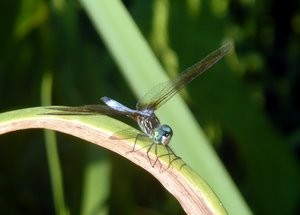 This article and the photograph accompanying it are the fruits of a naturalist’s recent adventure at Melvin L. Newman Wetlands Center, administered by the Clayton County Water Authority and located just south of Jonesboro, Georgia. On a sunny afternoon stroll along the boardwalks, bridges, and gravel paths there, this author encountered dragons, damsels, and even a robber awaiting its next victim. And he returned from his journey with numerous photographs to share as evidence of his exploits, included as a slide show. Yes, it is true that they were all insects: dragonflies, damselflies, and robber flies. But they were particularly intriguing and colorful ones, nonetheless, and made fitting characters for a natural history flight of fancy in the midst of a Georgia summer.
This article and the photograph accompanying it are the fruits of a naturalist’s recent adventure at Melvin L. Newman Wetlands Center, administered by the Clayton County Water Authority and located just south of Jonesboro, Georgia. On a sunny afternoon stroll along the boardwalks, bridges, and gravel paths there, this author encountered dragons, damsels, and even a robber awaiting its next victim. And he returned from his journey with numerous photographs to share as evidence of his exploits, included as a slide show. Yes, it is true that they were all insects: dragonflies, damselflies, and robber flies. But they were particularly intriguing and colorful ones, nonetheless, and made fitting characters for a natural history flight of fancy in the midst of a Georgia summer.
The wetland edges were filled with dragonflies where the waters were still, and occasional damselflies near flowing sections. The insects were typically either flying about or perching on a cattail or other bit of tall vegetation. Dragonflies and damselflies are insects belonging to the order Odonata, also known as odonates. Odonates are characterized by having long, slender bodies with two sets of veined wings and large compound eyes.They also have life cycles with two parts. After hatching, odonate larvae live underwater in streams and ponds, preying on other insect larvae (including mosquitoes). During the larval stage, they tend to be dull in color, enabling them to blend into the rocks, mud, and underwater vegetation to avoid being eaten by a fish, turtle, frog, or bird. Then, after going through several molts enabling the larvae to grow, they climb up out of the water for a final molt, emerging as a winged adult. As adults, they are swift and fierce predators of other insects (including adult mosquitoes). Many are brightly colored, with brilliant shades of blue, green, and red, like flying jewels. (Indeed, one common damselfly in Piedmont Georgia, present at Newman Wetlands Center, is called the ebony jewelwing.)
While dragonflies and damselflies do not appear to have lived in Middle Earth (at least not as described by Tolkien in The Lord of the Rings), they were abundant way back in the Carboniferous Period, over 300 million years ago, long before there were mammals or even dinosaurs. Fossils reveal that the early dragonflies were enormous, with wingspans up to one meter. In that time before birds or even pterodactyls, they were the mighty predators of the air, patrolling the Carboniferous swamps where tree ferns and giant club mosses grew.
While odonates are much smaller nowadays, several Georgia dragonflies have bodies approaching 6 cm in length, with 10 cm wingspans. They are are at once fabulous and frustrating to photograph. Odonates are large and often dazzling in color, making them easy to spot. They frequently rest atop high vegetation, sometimes perching there to watch for prey, other times pointing the abdomens into the air in a behavior known as obelisking (a means of keeping cool by reducing exposure to the sun). Dragonflies, in this writer’s experience, tend to be more willing subjects for the photographer, frequently landing a few feet away along a boardwalk or on a nearby cattail stalk. If disturbed, they often take off, only to circle for a moment and then land again in nearly the same location as before. Damselflies, on the other hand, are exceedingly coy. They seem to sense when a photographer is getting ready to take a picture, dashing off to another branch a bit further way. Once the photographer has focused on the damselfly on its new perch, it abruptly takes off again.
Besides these behavioral distinctions (which may have had more to do with the particular odonate specimens that this author encountered on his walk) there are a couple of important anatomical differences between dragonflies and damselflies. Dragonflies belong to the sub-order Anisoptera, roughly meaning “unequal wings”, in reference to the fact that their two sets of wings are not the same size. They also tend to have larger. stockier bodies. At rest, they spread their wings out horizontally. Damselflies, on the other hand, belong to the sub-order Zygoptera, “equal wings”. Their sets of wings are the same size, and at rest, nearly all damselflies hold their wings vertically (though there is a group of damselflies called the spreadwings that doesn’t follow that pattern). In general, damselflies tend to be much smaller and daintier than dragonflies.
Dragonflies were especially abundant and diverse; this author photographed members of four different species and glimpsed a few others that got away without being captured by the lens. After a couple of attempts, he also photographed a lone species of damselfly. Fortunately, Giff Beaton recently published Dragonflies and Damselflies of Georgia and the Southeast. As a result of the superb photographs and species accounts in that guide, this author was able to identify each odonate to the species level with ease, and even determine whether the subjects were immature or adult and male or female.
There was a single robber fly sighting, too. It was resting on a wooden fence in the shade toward the end of this writer’s walk. Close up, it has a fairly ferocious appearance that fits its character well. A master predator, its victims commonly include bees and wasps, which it consumes by sucking the juices from their bodies. Members of the family Asilidae, robber flies are quite diverse in and of themselves, although decidedly less colorful and elegant than their odonate cousins. Not yet having merited a common field guide devoted to them, robber flies cannot be classified down to the species level using rudimentary guidebooks (such as the National Audobon Society’s otherwise excellent Field Guide to Insects & Spiders).
The result of the afternoon adventure is a collection of photographs, along with memories of “the ones that got away”. The reader might argue that this author’s exploits fall short of deserving a poetic cycle in the style of Homer, or even an ode, for that matter. But there is some satisfaction, this writer believes, in knowing that hunting for dragonflies and damselflies is actually becoming a popular pastime (if not yet on the scale of birding). Named after the odonates themselves, the hobby is known as oding.
This article was originally published on 5 July 2010.
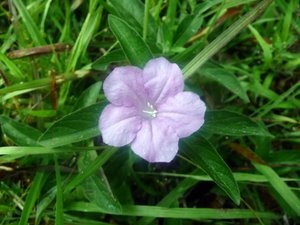 Purple is a color that usually evokes late summer: the deep, dark purple of pokeweed berries (just now coming into bloom here in Georgia) and the succulent reddish-purple of the muscadines. But even now, on the cusp of the summer solstice, the observant naturalist can discover abundant shades of purple, from pinkish tones to violet ones, on a roadside walk. A brief stroll along the road edges here in Chattahoochee Hills, Georgia, revealed enough purple tones to write about: three flowers and two early fruits. The first flash of purple was toward the pinkish-blue shade, catching the eye amongst the various greens of roadside grasses and weeds. This five-petaled beauty (shown on the left) is a hairy ruellia (Ruellia caroliniensis), also known as Carolina wild petunia. A trumpet-shaped flower about one inch across, it looks like the kind of flower that would be found on a Hawaiian lei. Indeed, the genus Ruellia is largely a tropical one. Common throughout the eastern and central U.S., this perennial wildflower bears blooms that last for only one day.
Purple is a color that usually evokes late summer: the deep, dark purple of pokeweed berries (just now coming into bloom here in Georgia) and the succulent reddish-purple of the muscadines. But even now, on the cusp of the summer solstice, the observant naturalist can discover abundant shades of purple, from pinkish tones to violet ones, on a roadside walk. A brief stroll along the road edges here in Chattahoochee Hills, Georgia, revealed enough purple tones to write about: three flowers and two early fruits. The first flash of purple was toward the pinkish-blue shade, catching the eye amongst the various greens of roadside grasses and weeds. This five-petaled beauty (shown on the left) is a hairy ruellia (Ruellia caroliniensis), also known as Carolina wild petunia. A trumpet-shaped flower about one inch across, it looks like the kind of flower that would be found on a Hawaiian lei. Indeed, the genus Ruellia is largely a tropical one. Common throughout the eastern and central U.S., this perennial wildflower bears blooms that last for only one day.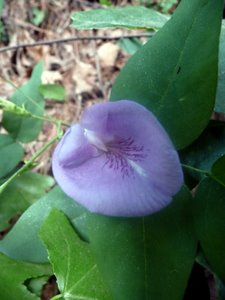 The gravel road passes through a wooded area with a canopy of loblolly pine and sweetgum, and an understory of oaks, black cherries, and persimmons. On a steep bank beside the road, in the shade, a stunning pinkish lavender flower is in bloom. Its irregular shape indicates that it is a member of the pea family (Fabaceae). Called butterfly pea (Clitoria mariana), it is a native perennial common to open areas throughout the eastern U.S. Another primarily tropical genus, Clitoria is abundant in Southeast Asia, where flowers are used for dyes and are also batter-dipped and deep-fried. Only two members of Clitoria are found in the U.S.; the second one (Clitoria fragrans) is restricted to sandlands in Florida. For those wondering, the rather racy genus name comes from the shape of the flower.
The gravel road passes through a wooded area with a canopy of loblolly pine and sweetgum, and an understory of oaks, black cherries, and persimmons. On a steep bank beside the road, in the shade, a stunning pinkish lavender flower is in bloom. Its irregular shape indicates that it is a member of the pea family (Fabaceae). Called butterfly pea (Clitoria mariana), it is a native perennial common to open areas throughout the eastern U.S. Another primarily tropical genus, Clitoria is abundant in Southeast Asia, where flowers are used for dyes and are also batter-dipped and deep-fried. Only two members of Clitoria are found in the U.S.; the second one (Clitoria fragrans) is restricted to sandlands in Florida. For those wondering, the rather racy genus name comes from the shape of the flower.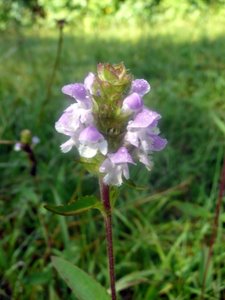 Back out into the sunlight of a steamy late June morning, and along a grassy verge, a number of tiny violet and white flowers are in bloom in a short, cylindrical spike atop a stalk about one and a half feet tall. A Eurasian roadside wildflower, heal-all (Prunella vulgaris) is a member of the mint family (Lamiaceae). As its name suggests, heal-all has been used as a traditional folk remedy for many complains. The leaf tea, for instance, was used to treat mouth sores, sore throats, fevers, and diarrhea, while a poultice from this plant has been used for treating wounds, Chemcial analysis of this plant has revealed that it contains compounds with antibiotic, anti-tumor, and hypertensive properties. It contains large quantities of a powerful antioxidant called rosmarinic acid (named for rosemary, which also contains the compound).
Back out into the sunlight of a steamy late June morning, and along a grassy verge, a number of tiny violet and white flowers are in bloom in a short, cylindrical spike atop a stalk about one and a half feet tall. A Eurasian roadside wildflower, heal-all (Prunella vulgaris) is a member of the mint family (Lamiaceae). As its name suggests, heal-all has been used as a traditional folk remedy for many complains. The leaf tea, for instance, was used to treat mouth sores, sore throats, fevers, and diarrhea, while a poultice from this plant has been used for treating wounds, Chemcial analysis of this plant has revealed that it contains compounds with antibiotic, anti-tumor, and hypertensive properties. It contains large quantities of a powerful antioxidant called rosmarinic acid (named for rosemary, which also contains the compound).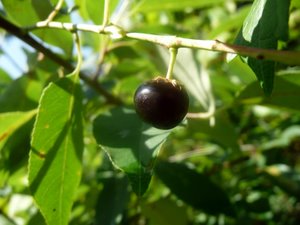 On the way home along the edge of a loblolly pine woods, a small dark purple fruit less than half an inch in diameter can be seen among the eliptical leaves of an understory tree. The fruit belongs to the black cherry (Prunus serotina), a much-prized deciduous tree common to the eastern and central U.S. Although the fruit is somewhat bitter, it is edible, and is often used for making wine and preserves. Birds feast on the fruits, while deer and other animals eat the leaves. Extracts of the inner bark are also used to make cough syrup. The wood of mature trees has a fine grain and rich orange-rose color, and is much valued by furniture-makers.
On the way home along the edge of a loblolly pine woods, a small dark purple fruit less than half an inch in diameter can be seen among the eliptical leaves of an understory tree. The fruit belongs to the black cherry (Prunus serotina), a much-prized deciduous tree common to the eastern and central U.S. Although the fruit is somewhat bitter, it is edible, and is often used for making wine and preserves. Birds feast on the fruits, while deer and other animals eat the leaves. Extracts of the inner bark are also used to make cough syrup. The wood of mature trees has a fine grain and rich orange-rose color, and is much valued by furniture-makers.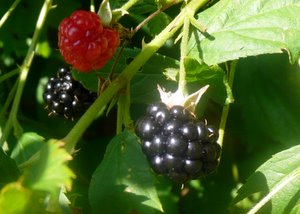 Not far from the black cherry tree is a dense thicket of shrubs and vines edging a roadside stream. Amongst the tangle of grape vines and elderberry bushes grow a number of black raspberries (Rubus occidentalis) just coming into fruit. The deep purple to black orbs look inviting, but first must be inspected carefully for ants that are also dining on them. This thorny cane, common in disturbed areas in the Eastern U.S., appears quite similar to the southern blackberry (Rubus argutus). However, while the black raspberry fruits separate easily from their receptacles (as evident in the photograph above), blackberry fruits do not. After several minutes of carefully investigating this year’s black raspberry harvest, this author returned home, purple-fingered and purple-tongued.
Not far from the black cherry tree is a dense thicket of shrubs and vines edging a roadside stream. Amongst the tangle of grape vines and elderberry bushes grow a number of black raspberries (Rubus occidentalis) just coming into fruit. The deep purple to black orbs look inviting, but first must be inspected carefully for ants that are also dining on them. This thorny cane, common in disturbed areas in the Eastern U.S., appears quite similar to the southern blackberry (Rubus argutus). However, while the black raspberry fruits separate easily from their receptacles (as evident in the photograph above), blackberry fruits do not. After several minutes of carefully investigating this year’s black raspberry harvest, this author returned home, purple-fingered and purple-tongued.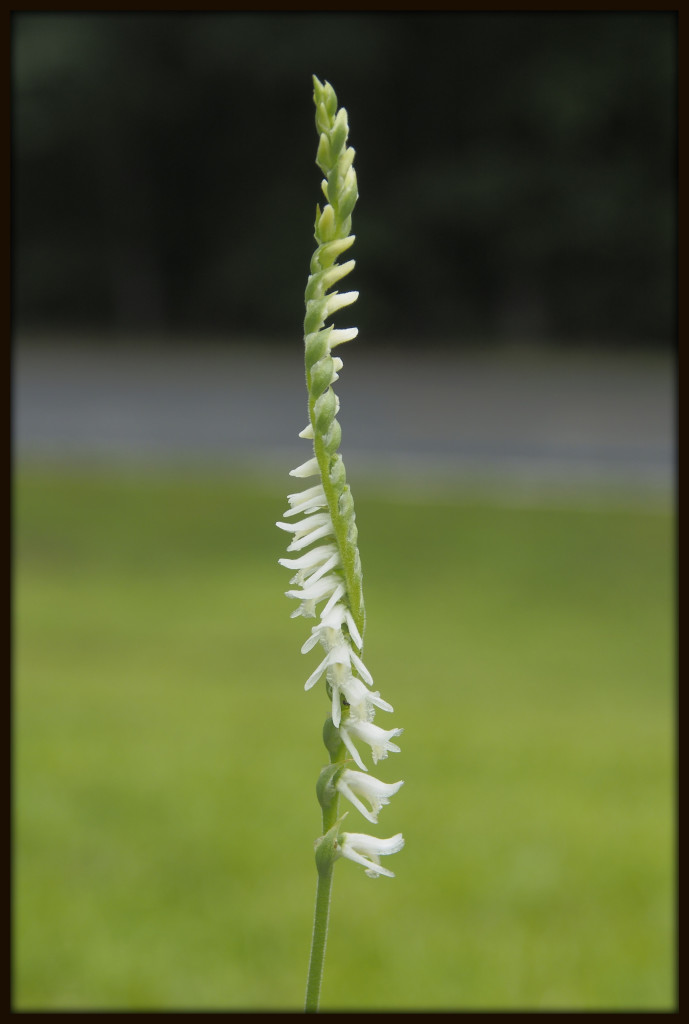 There is much to be said for leaving a lawn untouched. First there is the matter of money and labor associated with applying various fertilizers and weed-killers. Then there is the blatant fact that a well-tended lawn is boring. It is analogous to an outdoor carpet: single tone of color, a few species of grasses (perhaps only one), few insects (and therefore few insect predators as well). But if one leaves a lawn alone, wonderful things can begin to happen.
There is much to be said for leaving a lawn untouched. First there is the matter of money and labor associated with applying various fertilizers and weed-killers. Then there is the blatant fact that a well-tended lawn is boring. It is analogous to an outdoor carpet: single tone of color, a few species of grasses (perhaps only one), few insects (and therefore few insect predators as well). But if one leaves a lawn alone, wonderful things can begin to happen.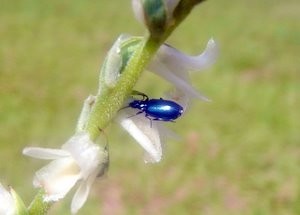 One particular little ladies’ tresses was being visited by a small beetle when the author photographed it on a morning in mid-June (see photograph on the right). The beetle was metallic black in color, and less about half a centimeter long, and perched on one of the flower blossoms. According to
One particular little ladies’ tresses was being visited by a small beetle when the author photographed it on a morning in mid-June (see photograph on the right). The beetle was metallic black in color, and less about half a centimeter long, and perched on one of the flower blossoms. According to  The southern magnolia (Magnolia grandiflora) is of an ancient lineage. Emblem of the old South, its roots reach back much further into the evolutionary past.
The southern magnolia (Magnolia grandiflora) is of an ancient lineage. Emblem of the old South, its roots reach back much further into the evolutionary past. 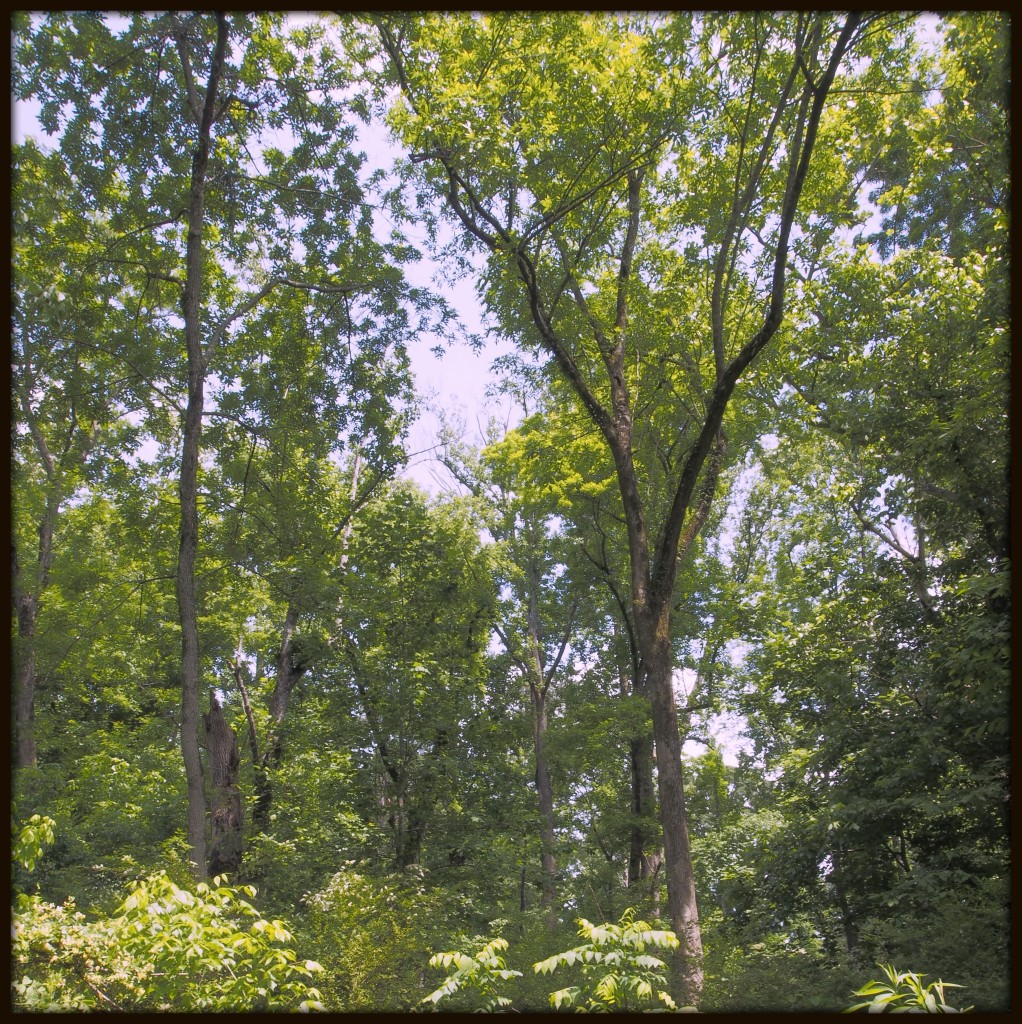
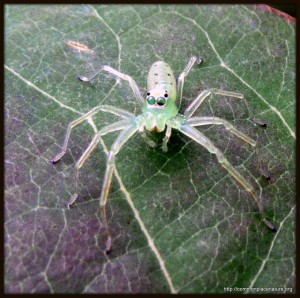






.JPG)



.JPG)



 Now that all of our deciduous trees are in leaf, and roadside ditches and forest floors in the Georgia Piedmont are green with life, it is a marvelous time to take a walk and see how many different leaf shapes you can find. Many shapes are particular to a certain kind of tree, shrub, or vine; some, like that of the maple, have even been celebrated on a country’s flag. There are the three jagged leaflets of poison ivy, and five of Virginia creeper; the many lobes (rounded or jagged) of the oaks; the tulip-shaped leaves of the tulip tree tree; the five-pointed star of the sweet gum; and the heart-shaped leaves of the wild yam. Some plants cannot settle upon one leaf shape, but instead have several. Leaves of the sassafras tree can be simple ovals, shaped like mittens, or have three broad, blunt lobes.
Now that all of our deciduous trees are in leaf, and roadside ditches and forest floors in the Georgia Piedmont are green with life, it is a marvelous time to take a walk and see how many different leaf shapes you can find. Many shapes are particular to a certain kind of tree, shrub, or vine; some, like that of the maple, have even been celebrated on a country’s flag. There are the three jagged leaflets of poison ivy, and five of Virginia creeper; the many lobes (rounded or jagged) of the oaks; the tulip-shaped leaves of the tulip tree tree; the five-pointed star of the sweet gum; and the heart-shaped leaves of the wild yam. Some plants cannot settle upon one leaf shape, but instead have several. Leaves of the sassafras tree can be simple ovals, shaped like mittens, or have three broad, blunt lobes. As spring advances, the observant naturalist notices an array of flowers coming into bloom along roadsides and forest paths. One flower blooming now that is easily missed belongs to a leafy vine that should not be overlooked: poison ivy (Toxicodendron radicans). Few of our native plants have as black a reputation as this member of the cashew family, frequently encountered along forest edges, roadsides, and in other disturbed areas. After all, how many other native plants are the subject of rhymes about their dangers? “Leaflets three / let them be.”
As spring advances, the observant naturalist notices an array of flowers coming into bloom along roadsides and forest paths. One flower blooming now that is easily missed belongs to a leafy vine that should not be overlooked: poison ivy (Toxicodendron radicans). Few of our native plants have as black a reputation as this member of the cashew family, frequently encountered along forest edges, roadsides, and in other disturbed areas. After all, how many other native plants are the subject of rhymes about their dangers? “Leaflets three / let them be.”